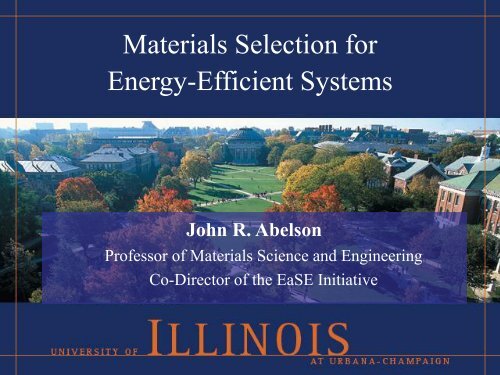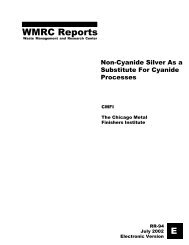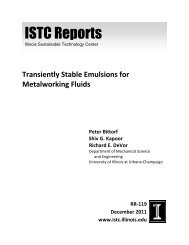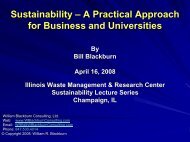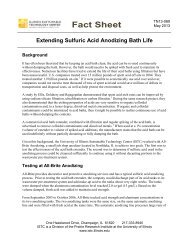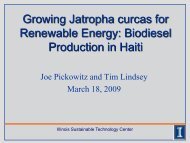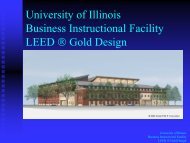Materials Selection for Energy-Efficient Systems
Materials Selection for Energy-Efficient Systems
Materials Selection for Energy-Efficient Systems
You also want an ePaper? Increase the reach of your titles
YUMPU automatically turns print PDFs into web optimized ePapers that Google loves.
<strong>Materials</strong> <strong>Selection</strong> <strong>for</strong><br />
<br />
<strong>Energy</strong>-<strong>Efficient</strong> <strong>Systems</strong><br />
John R. Abelson<br />
Professor of <strong>Materials</strong> Science and Engineering<br />
Co-Director of the EaSE Initiative
Senior / Graduate Course<br />
MSE 489, <strong>Materials</strong> <strong>Selection</strong> <strong>for</strong> Sustainability<br />
Basis of the course<br />
Supplementary<br />
in<strong>for</strong>mation
Dependence on Non-renewable <strong>Materials</strong>
How Does the Choice of Material<br />
Influence <strong>Energy</strong> Consumption?
Container: How Much <strong>Energy</strong> & CO2<br />
Associated with Phases of Life Cycle?<br />
Synthesize polymer<br />
Mold bottle and cap<br />
Fill in French Alps<br />
Ship to Cambridge<br />
Refrigerate and serve<br />
Recycle
Basis <strong>for</strong> Comparison: Unit of Function
Compare <strong>Energy</strong> Use in Products
Eco-Data in CES <strong>for</strong> > 2900 <strong>Materials</strong>!
How Do <strong>Materials</strong> Influence <strong>Energy</strong> Use,<br />
CO2 Emissions and Sustainability?<br />
Consider a proposed functional object or system. We need:<br />
1. A preliminary design that achieves the function and sets necessary constraints<br />
2. A statement of the engineering objectives <strong>for</strong> each component in the design<br />
3. A methodology to calculate a figure of merit <strong>for</strong> each component<br />
4. A figure of merit <strong>for</strong> the ecological implications (embodied energy, CO2<br />
footprint, water consumption, …) <strong>for</strong> each candidate material<br />
5. An optimization (tradeoff) method to select the best material<br />
6. A method to estimate the life cycle environmental costs
Derive <strong>Materials</strong> Per<strong>for</strong>mance Indexies<br />
Example: Component subject to principle mechanical stress<br />
But the methodology works <strong>for</strong> any property (thermal, electrical,…)
Derive <strong>Materials</strong> Per<strong>for</strong>mance Indexes<br />
Nutshell story: We have to keep the fixed parameters. But we can ratio out<br />
the free variables (e.g. cross-sectional area). In the resulting equation, the<br />
materials properties are separated from the engineering terms.<br />
Example: A beam subject to a bending load…<br />
m AL mass of beam<br />
S CEI<br />
L 3 stiffness of beam; C = const., E = modulus<br />
I A2<br />
second moment of area (square beam)<br />
12<br />
Eliminate area A<br />
<br />
m 12SL3 <br />
<br />
C <br />
1 2<br />
L<br />
<br />
<strong>Materials</strong> selection<br />
<br />
<br />
<br />
<br />
E 1 2<br />
<br />
<br />
<br />
: Need to minimize<br />
<br />
E 1 2<br />
!
<strong>Materials</strong> Per<strong>for</strong>mance Indexies
Design with <strong>Materials</strong>: Example:<br />
Modulus vs. Density <strong>for</strong> all Families
The Ecological Extension…<br />
From the CES database:<br />
We know Embodied <strong>Energy</strong>, H (J/kg)<br />
We know CO2 Footprint, CO2 (kg/kg)<br />
All we need to do is multiply mass density by the above<br />
to obtain, <strong>for</strong> example, stiffness per embodied energy or<br />
stiffness per CO2 emitted to obtain<br />
Engineering design with energy & sustainability metrics
Modulus vs. Embodied <strong>Energy</strong>
Example: Material Substitution<br />
Save Fuel by reducing the Weight of a Car Bumper<br />
Function: Beam Subject to Bending<br />
Constraint: Required Yield Strength<br />
Objective: Minimize Lifecycle E<br />
Approach: Minimize Mass
How Does Weight of Auto<br />
Affect Fuel Consumption?
Tradeoff: Embodied vs. Use <strong>Energy</strong>
Tradeoff: Material vs. Use Cost
Argonne National Labs:<br />
<strong>Energy</strong> Savings of Lightweight Auto<br />
Reduce from 8.7 to 6.1 x 10 5 MJ (but is it recyclable?)
How Do We Know the Relative Importance<br />
of Material <strong>Energy</strong> vs. Use <strong>Energy</strong>?<br />
Note: A Life Cycle Analysis (LCA)<br />
is per<strong>for</strong>med after the fact…<br />
useless <strong>for</strong> design decisions!
Fast Approximation to a LCA:<br />
the Eco-Audit Tool in CES
Example: Electric Tea Kettle
Eco-Audit Tool
Eco-Audit Tool
Eco-Audit of Tea Kettle
Example: <strong>Energy</strong> in Architecture:<br />
Embodied vs. Use Energies<br />
The Equinox House by Ty Newell is net-zero in use energy.<br />
But how much embodied energy did it require to build?
Super-insulated “SIP” Construction:<br />
wood faces, styrofoam core<br />
• Walls & roof 12 in thick, ~ R44<br />
• 80 panels total<br />
• Panels pre-cut and sized, follow the pattern<br />
• Heaviest panel (8 x 24 ft) weighs ~ 400 lb
Connect the Panels…the Shell is Done
What are the Tradeoffs?<br />
• SIPs reduce the use of wood – a renewable<br />
material (there is no 2x4 framing)<br />
• SIPs increase the use of styrofoam – derived<br />
from fossil fuel (about 4000 cubic feet!)<br />
• Our question: how much styrofoam insulation is<br />
worthwhile?<br />
• Local data<br />
T = annual degree-days of heating / cooling<br />
= lifetime of the structure = 100 years
What the Math Reveals<br />
• Styofoam has an embodied energy<br />
H = 16 kW-hrs per lb of foam<br />
• The minimum lifetime energy use E liftime occurs when<br />
the embodied energy in the insulation equals the<br />
energy used in heating and cooling!<br />
• E lifetime = 2 [T (H K)] 1/2<br />
where K is the thermal conductivity<br />
• Optimized foam thickness<br />
d foam = [T (K / H)] 1/2<br />
• What can we learn from the CES database?
CES Calculation: Total E at Optimized d<br />
<strong>for</strong> different insulating materials<br />
Paper honeycomb (0.18)<br />
Polyurethane (0.08)<br />
Phenolic (0.035)<br />
Polystyrene (0.02)<br />
Polyurethane (0.16)<br />
Paper honeycomb (0.035)<br />
Carbon (0.05)<br />
Cork board<br />
Vermiculite<br />
Polyurethane, 8 in:<br />
8300 kW-h / year<br />
at $ 0.10 / kW-h,<br />
that’s $ 35 / month<br />
<strong>for</strong> operation<br />
But Equinox House<br />
uses a heat pump<br />
with COP ~ 2…
Let’s See What the Developers Do…<br />
1 inch styrofoam… only<br />
enough to sell the building
Conclusions<br />
• Must identify how an system uses energy: how much is<br />
– embodied in the materials, vs.<br />
– consumed in the operation?<br />
• Per<strong>for</strong>mance indicies guide the selection of materials<br />
<strong>for</strong> engineering per<strong>for</strong>mance and ecological impact<br />
• The Eco-audit tool guides design decisions in real time<br />
• Tradeoff methods identify the best materials according<br />
to the costs (simple or discounted…)<br />
• To be green requires real numbers and methods…<br />
and now you have them!


